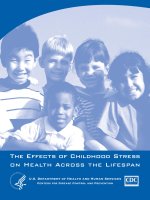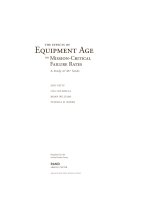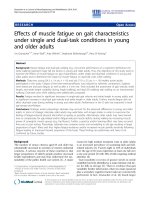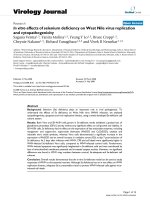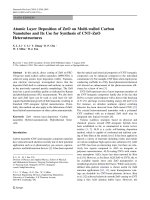The effects of fungal stress on the selected plant seeds and its applications for novel food development
Bạn đang xem bản rút gọn của tài liệu. Xem và tải ngay bản đầy đủ của tài liệu tại đây (2.12 MB, 204 trang )
THE EFFECTS OF FUNGAL STRESS ON THE
SELECTED PLANT SEEDS AND ITS
APPLICATIONS FOR NOVEL FOOD
DEVELOPMENT
FENG SHENGBAO
(B. Eng.)
A THESIS SUBMITTED FOR THE DEGREE OF DOCTOR OF
PHILOSOPHY
DEPARTMENT OF CHEMISTRY
NATIONAL UNIVERSITY OF SINGAPORE
2009
ACKNOWLEDGEMENTS
I would like to express my deepest gratitude and heartfelt thank to my supervisor,
Dr. Huang Dejian, who gave great influence to me for his encouragement and
invaluable advice all the way along. His endless support and constructive criticism
has been precious during these years.
I wish to thank my Co-supervisor, A/P Lee Yuan Kun, from Department of
Microbiology, for his guidance during my Ph.D. study.
My special thanks go to my former supervisor, A/P Philip J. Barlow for his
constant encouragement.
I would also like to thank the laboratory staff, Ms. Lee Chooi Lan, Miss Lew
Huey Lee and Miss Jiang Xiaohui who have helped extensively in the project.
Special thanks also go to Unicurd Food Company Pte. Ltd. (Singapore) for
helping me with the constant supply of experimental materials during the first step of
my postgraduate study.
The financial support from National University of Singapore is greatly
appreciated.
II
TABLE OF CONTENTS
ACKNOWLEDGEMENTS II
SUMMARY IX
LIST OF TABLES XI
LIST OF FIGURES XII
LIST OF ABBREVIATIONS XVII
LIST OF PUBLICATIONS XVIII
LIST OF ABSTRACTS AND PRESENTATIONS XX
CHAPTER 1 INTRODUCTION 1
1.1 Background 2
1.2 Objectives 6
CHAPTER 2 LITERATURE REVIEW 8
2.1 Secondary Metabolites in Plants 9
2.2 Phytoalexins in Plants 10
2.2.1 Phytoalexins Definition 10
2.2.2 Mechanisms of Phytoalexins Production 12
2.2.3 Elicitors of Phytoalexins Generation 17
2.2.4 Phytoalexins and Plant’s Disease Resistance 19
2.3 Soybean Phytoalexin: Glyceollins 21
2.3.1 Glyceollins Biosynthesis 21
2.3.2 Biological Properties of Glyceollins 26
III
CHAPTER 3 FUNGUS-STRESSED GERMINATION OF BLACK SOYBEANS
LEADS TO GENERATION OF OXOOCTADECADIENOIC ACIDS IN
ADDITION TO GLYCEOLLINS 29
3.1 Introduction 30
3.1.1 Soybean and its Nutritioninal Values 30
3.1.2 Secondary Metabolites in Soybean 30
3.1.3 Black Soybean 32
3.1.4 Objectives 33
3.2 Materials and Methods 34
3.2.1 Materials and Instruments 34
3.2.2 Black Soybean Germination and Fungal Inoculations 35
3.2.3 Compound Identification and Isolation 36
3.3 Results 39
3.3.1 Fungal Growth in Germinating Black Soybeans 39
3.3.2 Fungal Stress to Germinate KODES and Glyceollins 40
3.3.3 Characterization of KODES and KODE Glyceryl Esters 47
3.4 Discussion 50
3.5 Conclusion 55
CHAPTER 4 THE EFFECTS OF FUNGAL STRESS ON THE ANTIOXIDANT
CAPACITY OF GERMINATING BLACK SOYBEANS 56
4.1 Introduction 57
4.1.1 Antioxidants in Soybean 57
IV
4.1.2 Oxidative Stress and Reactive Oxygen Species (ROS) Generation 59
4.1.3 ROS Catalyzed Lipid Peroxidation in Soybeans 60
4.1.4 Objectives 62
4.2 Materials and Methods 62
4.2.1 Black Soybeans Germination and Fungal Inoculations 64
4.2.2 Sample Preparation and Extraction 65
4.2.3 Analytical Methods 65
4.2.3.1 Vitamin E Analysis 65
4.2.3.2 Quantification of Lipid Hydroperoxides 66
4.2.3.3 Measurement of Antioxidant Capacity in the Hydrophilic Extract
of Soybeans 67
4.2.3.4 Measurement of Antioxidant Capacity in the Lipophilic Extract of
Soybean 70
4.2.3.5 Determination of Total Phenolics in Black Soybeans 73
4.2.3.6 Isoflavones Analysis in Hydrophilic Extract of Black Soybeans
74
4.3 Results 74
4.3.1 Vitamin E 74
4.3.2 Lipid Peroxides 75
4.3.3 ORAC
oil
Value in Lipophilic Extract 75
4.3.4 Antioxidant 76
4.3.5 Total Phenolics Contents in Hydrophilic Extract 76
V
4.3.6 Isoflavones in Soybeans 79
4.4 Discussion 81
4.5 Conclusion 86
CHAPTER 5 NOVEL PROCESS OF FERMENTING FUNGUS-STRESSED
BLACK SOYBEAN [GLYCINE MAX (L.) MERRILL] YOGURT WITH
DRAMATICALLY REDUCED FLATULENCE - CAUSING
OLIGOSACCHARIDES BUT ENRICHED SOY PHYTOALEXINS 88
5.1 Introduction 89
5.1.1 Introduction of Yogurt 89
5.1.2 Nutritional Values and Health Benefits of Yogurt 90
5.1.3 Soy Yogurt and the Nutritional Values 93
5.1.4 Negative Effects in Soy Yogurt 95
5.1.5 Objectives 98
5.2 Materials and Methods 99
5.2.1 Materials 99
5.2.2 Black Soybean Germination under R. oligosporus Stress 99
5.2.3 Soy Yogurt Fermentation 100
5.2.4 Isoflavones, Glyceollins and KODES Analysis 101
5.2.5 Sucrose and Oligosaccharides Analysis 102
5.2.6 Viable Bacterial Count 104
5.2.7 Titratable Acidity 104
5.2.8 Statistics 104
VI
5.3 Results 104
5.3.1 Soy Yogurt Fermentation 104
5.3.2 Sucrose and Oligosaccharide Contents 106
5.3.3 Isoflavones, Total Glyceollins and Total KODES 108
5.4 Discussion 113
5.5 Conclusion 115
CHAPTER 6 CHARACTERIZATION OF SECONDARY METABOLITES IN
DURIAN SEEDS AND IN THE FUNGUS-STRESSED DURIAN SEEDS 117
6.1 Introduction 118
6.1.1 Proanthocyanidins in Plants – the Next Milestone in Flavonoid
Research 118
6.1.2 Secondary Metabolites in Durian Seeds 122
6.1.3 Objectives 124
6.2 Materials and Methods 124
6.2.1 Materials and Instruments 124
6.2.2 Sample Preparation and Extraction 125
6.2.3 Solvent Extraction and Fractionation of Durian Seeds 126
6.2.4 Extraction and Purification of Oligomeric Proanthocyanidins from
Durian Seeds 127
6.2.5 Oligomeric Proanthocyanidins Thiolysis and Identification 129
6.2.6 Quantitative Analysis using Normal Phase HPLC 130
6.2.7 Germination of Durian Seed with (without) Fungal Inoculation 130
VII
6.3 Results and Discussion 132
6.3.1 Chromatographic Fractionation of Durian Seed Extracts 132
6.3.2 Extraction and Structural Elucidation of OPCs 133
6.3.3 Determination of the Degree of Polymerization Procyanidins by
Thiolysis 139
6.3.4 Quantification of OPCs in Durian Seed using Normal Phase HPLC
141
6.3.5 Fungal Effect on the Germination of Durian Seeds 142
6.4 Conclusion 144
CHAPTER 7 CONCLUSIONS AND RECOMMENDATIONS 147
References 150
APPENDIX 172
VIII
SUMMARY
Secondary metabolites in plants have attracted worldwide attention partially due
to their far reaching health benefits. Among the complicated secondary metabolites,
phytoalexins are a special group of metabolites that are generated when the plants are
under oxidative stress. A few studies have reported the bioactivities of phytoalexins
but only little research had focused on their potent applications for pharmaceutical
and medicinal development. The objective of this research was to study the
phytoalexin production in stressed plant seeds and to develop phytoalexin enriched
food.
In Chapter 1 and Chapter 2, the backgrounds of phytoalexins generation were
introduced, the objectives of the study were proposed.
In Chapter 3, it was discovered that fungus-stressed germination of black
soybeans seeds led to the generation of a group of oxylipins, oxooctadecadienoic
acids (KODEs, including 13 - Z, E - KODE, 13 - E, E - KODE, 9 - E, Z - KODE, and
9 - E, E - KODE), and their respective glyceryl esters in addition to glyceollins, a
known group of phytoalexins present in wild and fungi infected soybeans. The
efficiency of four selected fungi in inducing the synthesis of these compounds during
black soybean germination was also compared.
In Chapter 4, the effects of R. oligosporus - caused oxidative stress to the
germinating black soybeans were further studied. Tocopherols, lipid peroxide
concentrations, isoflavones, the total phenolics contents and ORAC (Oxygen Radical
IX
Absorbance Capacity) values in the hydrophilic and lipophilic extracts of the treated
black soybeans were studied. Results suggested that fungal stress has no significant
effects on the antioxidant capacity of the black soybeans.
In Chapter 5, the fungi-stressed and germinated black soybeans were further
processed for functional food development. The treated black soybeans were
homogenized and fermented with lactic acid bacteria (LAB) to produce soy yogurt.
The resulting soy yogurt contained a maximum viable cell count of 2.1×10
8
CFU/mL
and had significantly altered the micronutrient profiles resulting in the markedly
reduced oligosaccharides but enriched glyceollins, which are known to have
anti-cancer properties.
In Chapter 6, durian seeds were chose for studying the contents of secondary
metabolites and phytoalexins generation after germination and fungus-stress.
Structural identification exhibited the distinctive characteristic of oligomeric
proanthocyanidins (OPCs) in durian seeds. The yield was 1.8 mg/g of dry seed.
13
C
and
1
H NMR signals showed the presence of procyanidins in the durian seeds. The
OPCs from durian seeds contain a significant amount of high order B-type oligomers
with predominantly epicatechins as the monomeric unit. The mean degree of
polymerization was determined to be 7.30. The effects of food grade R. oligosporus
stress on germinating durian seeds were also studied. New compounds but with low
concentrations were detected by HPLC analysis and were suggested to be
phytoalexins synthesized under stress conditions.
X
LIST OF TABLES
Table 2.1. Some of the Reported Elicitors and Corresponding Phytoalexins
Generated from Different Host-Pathogen Interactions 14
Table 3.1. Structural Classifications of Isoflavones 32
Table 3.2. Negative Ions (m/z) and Proposed Structures for Fragments of KODEs
49
Table 3.3.
1
H NMR Spectral Data for KODEs
a, b
49
Table 4.1. Some Reactive Oxygen Species Generated in the Oxidative Stressed
Host 61
Table 5.1. Sucrose and Oligosaccharide Concentrations in Black Soybeans,
Sterilized Soymilk and Soy Yogurt 110
Table 5.2. Isoflavones and Total KODES Concentrations (mg/g, dry matter) in
Soymilk and Soy Yogurt
a
112
Table 5.3. Comparison of pH Value, Titratable Acidity and Viable Lactic Acid
Bacteria in the Samples with Three Different Treated Methods
a, b, c
113
Table 6.1. Oligomeric Proanthocyanidins Profiles in Durian Seeds (unit: mg/g
dried seeds) 143
XI
LIST OF FIGURES
Figure 2.1. Structures of some reported phytoalexins (adapted from Albersheim et
al., 1986). 13
Figure 2.2. The important signaling transduction pathways in the wound, pathogens
or elicitors stressed plant cells. The figure is mainly based on the
observations in Arabidopsis (adapted from Hahlbrock, et al., 1986;
Walling, 2000; de Bruxells and Roberts, 2001). 16
Figure 2.3. Structure of an identified elicitor that contains phytoalexin eliciting
activities from Phytophthora megasperma var. sojae (Pms) mycelial
walls. G is the glucan unit (adapted from Ayers et al., 1976abc). 18
Figure 2.4. Structure of cis- and trans-resveratrol. 21
Figure 2.5. The structures of glyceollins I, II and III. 21
Figure 2.6. The early steps of glyceollins, isoflavones, lignin, anthocyanins,
flavones, and tannins biosynthesis start from phenylalanine. Dotted
arrows represent multiple steps; the block arrow represents speculative
steps (adapted from Kimpel and Kosuge, 1985). 23
Figure 2.7. Biosynthesis of glyceollins from daidzein. Enzymes joint in the
biosynthesis are: EC 1.14.13.89, isoflavone 2’-hydroxylase;
EC 1.3.1.51,
2'-hydroxydaidzein reductase; EC 1.1.1.246, pterocarpan synthase;
EC
1.14.13.28
, 3,9-dihydroxypterocarpan 6a-monooxygenase; EC 2.5.1.36,
trihydroxypterocarpan dimethylallyltransferase;
EC 1.14.13.85,
dimethylallyl-3,6a,9-trihydroxypterocarpan cyclase, which is the
glyceollin synthase (adapt from: Yu et al., 2003, MetaCyc Pathway).
. 25
Figure 3.1. General structure of isoflavones. 31
Figure 3.2. Appearance of different fungal stressed germinating black soybeans
after 3 days. Codes and identities: A, control, soybeans without fungal
stress; B, A. niger stressed soybeans; C, A. oryzae stressed; D, A. niger
sp. wry stressed soybeans; E, R. oligosporus stressed soybeans. 40
Figure 3.3. HPLC Chromatograms of UG black soybeans, G black soybeans after
three days and GS black soybeans with A. niger, A. oryzae, A. niger sp.
wry and R. oligosporus after three days. Peak identities: 1, genistin; 2,
XII
malonyl daidzin; 3, malonyl glycitin; 4, daidzein; 5, glycitein; 6,
malonyl genistin; 7, genistein; 8 – 9 glyceollins; 10, KODE glyceryl
esters; 11, KODEs. 41
Figure 3.4. UV spectra of detected isoflavones, glyceollins (peak 9), KODE glyceryl
esters (peak 10 associated peaks) and KODES (peak 11 and associated
peaks). 42
Figure 3.5. Glyceollins and KODEs production with Rhizopus sp. fermentation on
black soybeans in a three days time course study. Peaks and identities: 1,
glyceollins; 2, KODE glyceryl esters; 3, KODES. 45
Figure 3.6. Comparison of the concentrations of glyceollins, KODEs and KODE
glyceryl esters in the black soybeans stressed by four different fungal
strains with a three - day germination. All the runs were in triplicate. 45
Figure 3.7. A representative ESI (positive and negative ion) mass spectrum of
glyceollin I. 46
Figure 3.8. The structures of oxooctadecadienoic acids (KODEs) and their
respective glyceryl esters. 48
Figure 3.9. The proposed pathways for enzymatic formation of 13 - E, E – KODE
via linoleic acid in fungi-stressed germination of black soybeans. 52
Figure 3.10. HPLC Chromatograms of the extract of R. oligosporus stressed black
soybeans after three days. Hydroperoxyoctadecadienoic acid (HPODE)
was detected at wavelength of 234 nm. 54
Figure 4.1. A structure unit of isoflavones. The antioxidant activity of the isoflavone
is affected by the number and position of hydroxyl groups. 58
Figure 4.2. Structures of tocopherols and tocotrienols. 58
Figure 4.3. The chemical structures of fluorescein, AAPH, and trolox. 68
Figure 4.4. A representative kinetic curve of ORAC measurement during a two-hour
instrumental read. The time interval between two readings is one minute.
A blank curve and three sample curves were shown here. The shadow
area represents the net AUC of one sample, i.e.
AUC
sample
-AUC
blank
.
70
XIII
Figure 4.5. A nomalized kinetic curve of oxygen consumption during two hours
instrumental reading. The time interval between two readings is one
minute. Only blank curve and a sample curve were shown here. The
shadow area represents the net AUC of the sample, i.e.
AUC
sample
-AUC
blank
. 72
Figure 4.6. Comparison of α-, γ-, and δ-tocopherol changes in a 3-day time course
study between non-stressed germinating black soybeans and R.
oligosporus stressed germinating black soybeans. Code and identities: G,
germinated beans sample; GS, germinated beans sample under R.
oligosporus stress. 77
Figure 4.7. Comparison of lipid peroxides concentration in a 3-day time course
study between non-stressed germinating black soybeans and R.
oligosporus stressed germinating black soybeans. Code and identities: G,
germinated beans sample; GS,
germinated beans sample under R.
oligosporus stress. 78
Figure 4.8. Comparison of ORAC
oil
values in a 3-day time course study between
non-stressed germinating black soybeans and R. oligosporus stressed
germinating black soybeans. Code and identities: G, germinated beans
sample; GS, germinated beans sample under R. oligosporus stress. 78
Figure 4.9. Comparison of ORAC values of the hydrophilic extract in a 3-day time
course study between non-stressed germinating black soybeans and R.
oligosporus stressed germinating black soybeans. Code and identities: G,
germinated beans sample; GS, germinated beans sample under R.
oligosporus stress. 79
Figure 4.10. Comparison of the total phenolics concentration of the hydrophilic
extract in a 3-day time course study between non-stressed germinating
black soybeans and R. oligosporus stressed germinating black soybeans.
Code and identities: G, germinated beans sample; GS,
germinated beans
sample under R. oligosporus stress. 79
Figure 4.11. The changes of isoflavones contents in the hydrophilic extract of
non-stressed germinating black soybeans and R. oligosporus stressed
germinating black soybeans in a 3-day time course study. 81
Figure 4.12. Changes of total isoflavones contents in the hydrophilic extract of
non-stressed germinating black soybeans and R. oligosporus stressed
germinating black soybeans in a 3-day time course study. Code and
identities: G, germinated beans sample; GS,
germinated beans sample
under R. oligosporus stress. 84
XIV
Figure 4.13. The total ORAC values of isoflavones in the hydrophilic extract of
non-stressed germinating black soybeans and R. oligosporus stressed
germinating black soybeans in a 3-day time course study. Code and
identities: G, germinated beans sample; GS,
germinated beans sample
under R. oligosporus stress. 85
Figure 5.1. The essential process of yogurt making (adapted from Tamime and
Robinson, 1999) 91
Figure 5.2. The chemical structures of soybean oligosaccharides that can cause
flatulence. 97
Figure 5.3. Flowchart of fermentation processes of the soy yogurt. R. oligosporus
culture powder (1.0 g) was dissolved in 15 mL of sterile deionized water
and applied to the soybeans (15 mL of fungal solution inoculated into
200 g of black soybeans). The LAB culture powder was diluted in
sterilized cow’s milk and inoculated onto the sterilized soy milk
according to the guidelines (5 units diluted in 250 mL of milk). The soy
milk was inoculated with 1.0 mL of the prepared LAB starter culture
solution (0.02 units per 100 mL) and incubated at 37-41
o
C for 24 h.
101
Figure 5.4. Black soybean milks (top three bottles) after different treatment and the
respective fermented yogurt (bottom three bottles). The fermentation
conditions were: inoculum, 0.02U of FD-DVS YC-X11 LAB starter
culture inoculated 100 mL of soymilk; Incubation, 37 - 41
o
C for 24
hours. Code and identities: UG, control (ungerminated yogurt); G,
germinated beans yogurt; GS,
germinated beans under R. oligosporus
stress yogurt. 106
Figure 5.5. HPLC chromatogram of saccharides in ungerminated black soybeans
(UG), germinated without stress (G), and germinated with R.
oligosporus stress (GS). The sugar identities were verified by spiking
the samples with standards, respectively. 109
Figure 6.1. Structures of the flavan-3-ol building blocks (1 and 2) of
proanthocyanidins, B-type (3), and A-type (4) dimeric blocks of
proanthocyanidins. B-type (dimeric) are characterized by single linked
flavanyl units between C-4 and C-8 (3) or C-6 (not shown), while
A-type possess an additional ether linkage between C-2 of the upper unit
and a 7- and/or 5-OH of the lower unit. Where R
1
= H and R
2
= OH,
catechin; R
1
= OH and R
2
= H, epicatechin (adapted from Cos, et al.,
2004; Skerget et al., 2005). 120
XV
Figure 6.2. Images of germinated durian seeds with R.oligosporus stress (GS, right)
and without R. oligosporus stress (G, left) for three days. 131
Figure 6.3. Flash chromatograms of durian seed extract (C
18
column). The detector
wavelength is 280 nm. 133
Figure 6.4.
13
C{
1
H} NMR spectrum of proanthocyanidins from durian seed. Sample
was dissolved in deuterate methanol and the data were collected at room
temperature with operating frequency of 75 MHz. 134
Figure 6.5. ESI-MS spectrum of purified OPCs collected under anionic mode. A
series of peaks were detected with m/z differing 288 starting from
monomer (289) and ending at hexamer (1730). A type dimer and trimer
were also detected as small peaks at m/z 575 and 863. Doubly charged
haptomer at 1008 was also found. 137
Figure 6.6. MALDI-TOF mass spectrum in positive linear mode, showing a
procyanidin series [M + Na
+
] from the trimer (m/z 889) to the nonamer
(m/z 3193). Inset is an enlarged spectrum of masses representing a
procyanidin series with the presence of protonated trimer at m/z 1155
and hydroxylated trimer at m/z 1193. Small amounts of gallated trimer
were also detected at m/z 1329 ( = 1177 + 152 (gallate)), and its
hydroxylated compound at m/z 1345. 139
Figure 6.7. HPLC chromatogram (detector wavelength = 280 nm) of thiolytic
products of durian seed OPCs by α-toluenethiol and the possible
thiolytic products detected by LC-MS spectra. A, catechin; B,
epicatechin; Structures of C, D, E, F, and I are shown in the Figure. G is
excessive α-toluenethiol, H is an unknown compound. 141
Figure 6.8. Normal phase HPLC separation of proanthocyanidins in durian seeds.
The numbers above the peaks indicate the degree of polymerization of
B-type procyanidins. The broad peaks are likely caused by the rotamers
of proanthocyanidins arising from the hindered rotations of interflavanol
C-C bonds. 143
Figure 6.9. HPLC chromatogram of the extract of durian seed (without germination
– control), germinated seed without stress and germinated seed under
fungal attack (Detection wavelength at 234 nm). The left box highlights
the OPCs; the right box indicates the presence of new peaks. 146
XVI
LIST OF ABBREVIATIONS
KODE: oxooctadecadienoic acids
HPLC: high performance liquid chromatography
ESI-MS: electrospray ionization- mass spectrometry
MALDI-TOF MS: matrix assisted laser desorption-time of flight mass
spectrometry
ORAC: oxygen radical absorbance capacity
ORAC
oil
: oxygen radical absorbance capacity in bulk oil
ROS: reactive oxygen species
AUC: area under curve
LAB: lactic acid bacteria
XVII
LIST OF PUBLICATIONS
Publications
1. Feng S.; Saw C. L.; Lee Y. K. Huang D. Novel process of fermenting black
soybean [Glycine max (L.) Merrill] yogurt with dramatically reduced
flatulence-causing oligosaccharides but enriched soy phytoalexins. J. Agric. Food
Chem. 2008,
56, 10078–10084.
2. Feng S.; Huang D. Soy good: A novel soy yogurt with dramatically improved
nutritional profiles. SIFST Annual, In Food and Beverage Asia,
2007, 17-19
3. Feng S.; Saw C. L.; Lee Y. K.; Huang D. Fungal-stressed germination of black
soybeans leads to generation of oxooctadecadienoic acids in addition to
glyceollins. J. Agric. Food Chem. 2007, 55, 8589–8595.
4. Gorinstin S.; Caspi A.; Libman I.; Lerner H. T.; Huang D.; Leontowicz H.;
Leontowicz M.; Tashma Z.; Katrich E.; Feng S.; Trakhtenberg, S. Red Grapefruit
Positively Influences Serum Triglyceride Level in Patients Suffering from
Coronary Atherosclerosis: Studies in Vitro and in Humans. J. Agric. Food Chem.
2006, 54, 1887-1892.
Patent
1. Huang D.; Feng S.; Lee Y. K.; Saw C. L. Novel soy yogurt and the processes of
making thereof. U.S. Provisional Patent, 60/912, 196. 2007.
XVIII
Manuscripts in preparation
1. Feng S.; Xie R. H.; Lee Y. K. and Huang D. Proanthocyanidins, the secondary
metabolites in durian seed and husk.
2. Feng S.; Lee Y. K. and Huang D. Effect of fungal stress on the oxidative status of
germinating black soybeans.
XIX
LIST OF ABSTRACTS AND PRESENTATIONS
1. Feng S.; Saw C. L.; Lee Y. K. Huang D. Enhanced black soy yogurt
micronutritional profiles through fungal stressed germination treatment. 14th
World Congress of Food Science and Technology, Shanghai, China, October
19-23, 2008.
2. Feng S.; Saw C. L.; Lee Y. K. Huang D. Novel soy yogurt and the processes of
making thereof. The 5th Singapore International Chemistry Conference (SICC-5),
Singapore, December 17-19, 2007.
3. Feng S.; Saw C. L.; Lee Y. K. Huang D. A novel soy yogurt fermented from
fungal-stressed and germinated black soybeans. The 4
th
Asia Conference On
Lactic Acid Bacteria and the 3
rd
International Symposium on Lactic Acid
Bacteria and Health. Shanghai, China, October 14-17, 2007.
4. Feng S. and Huang D. Isolation and characterization of new compounds from
fungal stressed germinating black soybeans, The SIFST Student Symposium, 2007.
Singapore Institute of Food Science & Technology and the 10th ASEAN Food
Conference, 20 April 2007.
5. Feng S.; Huang D.; Barlow P.J.; Lee Y. K. Nutritional values of soy yogurt and
cow’s milk yogurt: the comparative study, The First Graduate Congress of
Mathematic and Physical Science, Bangkok, Thailand, 06 December 2005.
XX
CHAPTER 1
INTRODUCTION
1
1.1 Background
Plants are probably the largest source of natural products with a molecular mass
diversity of over 100,000 which are known as secondary metabolites. Most of the
secondary metabolites are derived from isoprenoid, phenylpropanoid, alkaloid or fatty
acid/polyketide metabolism (Dixon, 2001; Hopkins, 2004). Secondary metabolites do
not directly participate in the
growth, development or reproduction of organisms. The
absence of these substances will not cause the immediate death, but in the long-term
may impair the organism’s survivability/fecundity (Croteau et al., 2000).
Comprehensive studies have been conducted on the natural products owing to their
potential biological activities. These phytochemicals are generally involved in defense
mechanisms against environmental stress (Hopkins, 2004) and have a great potential
to be developed as drugs, food ingredients and nutraceuticals (Croteau et al., 2000).
In the natural environment, wild plants frequently encounter severe environmental
threats such as microbial infection, drought, nutrient deficiency, mineral toxicity,
temperature, oxidative stresses and osmotic stress and so on (Semel et al., 2007). As a
response to these threats, the plants launch a two-pronged resistance: a short-term
response and a long-term specific response (de Bruxelles and Roberts, 2001). In the
short-term response, oxidative burst may occur as an early plant response to pathogen
infection with rapid and transient production of large amount of reactive oxygen
species (ROS), primarily superoxide (O
2
-
) and hydrogen peroxide (H
2
O
2
) to keep
plant on hypersensitive status. Upon pathogen infection, ROS denature cell membrane
protein and kill invading microbes (Guo et al., 1998). Consequently, the
2
apoptosis-compromised cells in the plants commit suicide to create a physical barrier
to the invader (de Bruxelles and Roberts, 2001). On the other hand, during long-term
response, or systemic acquired resistance (SAR) response, the infected tissue will
communicate with the rest of the plant using plant hormones. The reception of the
signal leads to whole-plant changes within the plants, associating with the induction
of a wide range of genes (named “pathogenesis-related” genes or PR genes) that
prevent the plants from further pathogen intrusion (Ryals et al., 1996; Heil et al.,
2002). At the same time, various enzymes will be activated which are involved with
the generation of phytoalexins (Welle et al., 1988; Purkayastha, 1995). Phytoalexins
are low molecular weight secondary metabolites within the group of flavonoids,
terpenoids, glycosteroids and alkaloids that are considered as plant antibiotics to
defend microbial infection and stress (Dixon, 2001). The discovery of phytoalexins
has been the foundation of plant pathology (Purkayastha, 1995). Upon organism
intrusion, phytoalexins synthesized in the plants will act as toxins to puncture the cell
wall of organisms and cause a delay of pathogen maturation. The pathogen
metabolism will be disrupted and its reproduction will be terminated (Walling, 2000;
de Bruxelles and Roberts, 2001)
Glyceollins are a group of phytoalexins synthesized in the plants that contain rich
isoflavones. Soybean seeds are the most frequently studied source in this aspect.
There are four isoflavones: daidzein, glycitein, genistein, and malonyl genistein with
twelve chemical entities (Murphy et al., 2002) but daidzein is the only precursor of
glyceollins (Burow et al., 2002). Glyceollins are not synthesized unless a group of
3
enzymes are activated. Series of enzymes had been identified that involved in the
biosynthesis of glyceollins. When pathogens invaded the soybean seeds,
phenylalanine ammonia-lyase, cinnamic acid 4-hydroxylase, 4-coumarate CoA ligase,
chalcone synthase, chalcone reductase and chalcone isomerase in the hypocotyls of
soybean seedlings are first activated stepwise to initiate the transformation from
phenylalanine to daidzein (Yu et al., 2003). Hydroxydaidzein, dihydroxypterocarpan
and prenylated pterocarpans, dimethylallylglycinol glyceollidins are important
intermediates formed during the biosynthesis. Glyceollins are finally synthesized
through glyceollidins cyclization by the glyceollins synthesis enzyme catalysis (Welle
et al., 1988).
Recently, scientists have begun to explore novel strategies for isolating plant
compounds of potential medicinal and functional food values. One rewarding research
area involves the emerging study of phytoalexins and their benefits on human health
(Mead, 2007). Resveratrol is probably the most well known phytoalexin isolated from
grapes and herbal plants. Resveratrol has antioxidant, anti-inflammation, and
anticancer activity (Baur et al., 1997). In addition, it acts as a calorie restriction (CR)
mimetic that extends the lifespan of laboratory animals (Sinclair, 2006; Fontana and
Klein 2007). It is suggested that resveratrol activates sirtuin pathways (Howitz, 2003)
and may also activate animal sirtuins and consequently exert the benefits of CR
(Wood et al., 2004).
Glyceollins, although not as recent as resveratrol, have attracted
wide attention in recent years for their marked bioactivities. Glyceollins are
synthesized from their precursor daidzein but have been proved to possess wider
4
bioactivities and stronger antimicrobial effects than daidzein and other isoflavones
(Burow et al., 2002). Some investigations suggested that glyceollins can be a very
promising hormone replacement therapy for conventional medicines. The most
interesting findings of glyceollins are the strong antiestrogenic effects and the abilities
to stop cancer cells from proliferating. Burow and coworkers (2002) demonstrated
that glyceollins have marked antiestrogenic effect on estrogen receptor (ER) signaling,
which correlated with a comparable suppression of 17b-estradiol-induced
proliferation in ER-positive estrogen-dependent MCF-7 human breast carcinoma cell
line. Further investigations revealed a greater antagonism of glyceollins towards ERα
than ERβ in transiently trans-infected ER-negative HEK 293 cells. The same research
group also compared the effects of glyceollins on the growth of MCF-7 breast cancer
cells and BG-1 ovarian cancer cells. Their investigation indicated that the glyceollins
suppressed MCF-7 tumor growth by 53.4% and BG-1 tumor growth by 73.1%,
compared to estradiol alone (a hormone replacement therapy). Interestingly,
glyceollins completely suppressed estradiol-induced expression of progesterone
receptors, which is one of the common side effects of estradiol, in MCF-7 cells and
partially suppressed their expression in the BG-1 cells. Thus, glyceollins seem to exert
its anticancer activity, in part, by interfering with the cancer cell’s ability to respond
to estradiol, the most potent endogenous estrogen and a major growth stimulus for
breast and ovarian cancers (Cleveland et al., 2006; Mead, 2007). Recently, animal
trials had been conducted in postmenopausal female monkeys with
5
